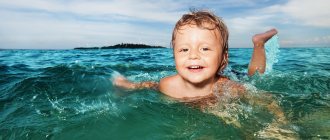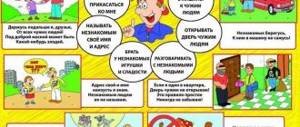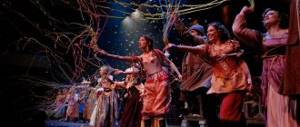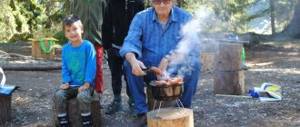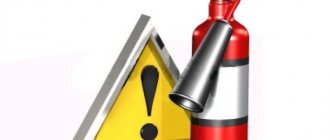Safety precautions in physical education class
Children should be taught safety rules during physical education lessons even before the start of training. These instructions and standards help prevent or minimize injuries during activities and are mandatory.
Below we will describe the most basic safety instructions in physical education lessons. Of course, any school can change this list to suit local requirements.
- During the educational process, there is a possibility of: being injured when falling on a hard surface, getting injured while throwing balls; risk of injury if you do not warm up well; get injured during sports games. In order to reduce all these risks of injury, it is necessary to comply with safety rules and requirements.
- Students who have completed a course on safety precautions may be admitted to physical education lessons.
- If a student is exempt from physical education, then he must be in class in any case.
- Students must change into sportswear.
- During training sessions, you should not eat or chew gum.
- To prevent students from getting sick, they should not drink cool water after playing sports.
Before leaving the hall
- The teacher first introduces TB to all schoolchildren in physical education class.
- Each student changes into a sports uniform. Be sure to have replaceable clean shoes, preferably with light-colored soles.
- Children need to remove hanging jewelry, watches, and uncomfortable hairpins that can cause injury. It is better not to leave valuables in the locker room, but to hand them over to the teacher for safekeeping.
- All kinds of sweets and chewing gum are prohibited during the lesson; seeds or dangerous objects (stabbing, cutting, flammable) are not brought here.
Child alone at home: rules of behavior and safety
Safety precautions in physical education lessons at school
- Before playing sports, you must change into appropriate clothing.
- Also remove and place in your pockets items that could be dangerous during class, such as a watch.
- Students, with the permission of the teacher, calmly prepare the equipment needed for the lesson.
- After the whistle, all students line up in one line.
During physical education classes:
- be sure to listen to the teacher when doing exercises and follow the safety instructions in physical education;
- You can perform exercises with equipment only after the teacher’s permission;
- run only on your designated road when running short distances;
- there is no need to stop abruptly to avoid collisions with other schoolchildren during races;
- Do not jump on a slippery or uneven surface, do not land after jumping on your hands;
- when performing throws, make sure that there are no schoolchildren in the throwing sector;
- keep your distance;
- You shouldn’t unexpectedly change your line of movement;
- do not disturb others and do not play around while doing exercises;
- If during class your health suddenly deteriorates or you receive an unexpected injury, then immediately inform the teacher about what happened to you.
Instructions on TB in physical education lessons in primary school, material on physical education on the topic
Safety briefing for students in the subject
"Physical Culture"
I. General safety requirements.
The student must:
- undergo a medical examination and study in the medical group to which he belongs for health reasons;
- have a neat sports uniform (pants, T-shirt, T-shirt, tracksuit, tights, clean shoes - sneakers, sneakers), appropriate to the weather conditions and the topic of the lesson;
- leave the locker room at the first request of the teacher;
- after illness, provide the teacher with a doctor’s certificate;
- be present at the lesson if the doctor releases you from classes after illness;
- treat sports equipment and equipment with care and use it for its intended purpose;
- have short-cropped nails;
- know and follow the safety instructions.
Students are not allowed to:
- open doors sharply and hang on them, turn off the lights, touch the lampshades in the locker room, gym;
- insert foreign objects into sockets;
- drink cold water before and after the lesson;
- practice on wet ground, slippery and uneven ground.
II. Safety requirements before starting classes.
The student must:
- change clothes in the locker room, put on sportswear and shoes;
- remove items that pose a danger to other students (earrings, watches, bracelets, etc.);
- remove sharp and other foreign objects from the pockets of the sports uniform;
- under the guidance of the teacher, prepare the supplies and equipment necessary for the lesson;
- with the permission of the teacher, go to the place where the lesson is being held;
- at the teacher’s command, get into formation for a general formation.
III. Safety requirements during classes.
The student must:
- listen carefully and clearly carry out the teacher’s tasks;
- take sports equipment and perform exercises with the permission of the teacher;
— while moving, look forward, maintain sufficient intervals and distances, avoid collisions;
- perform exercises with working equipment and practice on working equipment.
Students are not allowed to:
- leave the place of the lesson without the permission of the teacher;
— push, place steps in formation and movement;
— climb onto basketball forms, hang on hoops;
- chew chewing gum;
— interfere and distract when explaining tasks and performing exercises;
- perform exercises with wet palms;
- sharply change the direction of your movement.
IV. Safety requirements in case of accidents and extreme situations.
The student must:
- if you receive an injury or deteriorate in health, stop classes and notify the physical education teacher;
- with the help of the teacher, provide first aid to the injured person, if necessary, take him to the hospital or call an ambulance;
- if a fire occurs in the gym, immediately stop the lesson, leave the place of the lesson in an organized manner, under the guidance of the teacher, through emergency exits in accordance with the evacuation plan;
- by order of the teacher, notify the administration of the educational institution and report the fire to the fire department.
V. Safety requirements at the end of classes.
The student must:
- under the guidance of the teacher, remove sports equipment to its storage areas;
- leave the place of the lesson in an orderly manner;
- change clothes in the locker room, take off your tracksuit and sports shoes;
- Wash your hands with soap.
Occupational safety instructions for students on safety measures when practicing on outdoor sports grounds
I. General safety requirements.
The condition of the sports ground must meet sanitary and hygienic requirements. Non-standard equipment must be securely fastened and in good condition.
Students are allowed to take classes:
— those classified for health reasons into the main and preparatory medical groups;
— have undergone safety training;
- having sports shoes and a uniform that does not restrict movement and corresponds to the topic and conditions of the classes. Shoes should have non-slip soles, fit tightly to the foot and not impede blood circulation. In strong winds, low temperatures and high humidity, clothing must be appropriate for the weather conditions.
The student must:
- treat sports equipment and equipment with care, do not use it for other purposes;
— be careful when moving around the stadium;
- know and follow these instructions.
For failure to comply with security measures, a student may not be allowed or suspended from participating in the educational process.
II. Safety requirements before starting classes.
The student must:
- change clothes in the locker room, put on sportswear and shoes;
- remove items that pose a danger to other students (watches, earrings, etc.);
- remove sharp and other foreign objects from the pockets of the sports uniform;
— go out with the teacher in an orderly manner through the central exit of the building or the emergency exit of the gym to the place of classes;
— under the guidance of the teacher, prepare the inventory and equipment necessary for conducting classes;
- put equipment that will not be used in class in a safe place;
- under the guidance of the teacher, carry the equipment necessary for conducting classes to the place of classes in special devices;
- by order of the teacher, remove foreign objects from the treadmill, jumping pit, etc.;
- at the teacher’s command, get into formation for a general formation.
III. Safety requirements during classes.
Classes are held on flat, non-slip ground under the guidance of a physical education teacher.
The teacher is obliged:
- monitor students' compliance with instructions, rules of behavior in physical education lessons and make decisions on removing students from participation in the educational process for gross or systematic violation of them.
The student must:
- listen carefully to the explanations of the exercises and perform them correctly;
- take sports equipment and perform exercises with the permission of the teacher;
- perform exercises only on working equipment;
— when performing flow exercises, maintain sufficient interval and distance;
— be careful when moving around the sports field: do not disturb others, do not trip, avoid collisions;
- do not leave the territory of the sports ground without permission.
IV. Safety requirements in case of accidents and extreme situations.
The student must:
- if you receive an injury or deteriorate in health, stop classes and notify the physical education teacher;
- with the help of the teacher, provide first aid to the injured person, if necessary, take him to the hospital or call an ambulance;
- if a fire occurs in the gym, immediately stop the lesson, leave the place of the lesson in an organized manner, under the guidance of the teacher, through emergency exits in accordance with the evacuation plan;
- by order of the teacher, notify the administration of the educational institution and report the fire to the fire department.
V. Safety requirements at the end of classes.
The student must:
- under the guidance of the teacher, remove sports equipment to its storage areas;
- leave the place of the lesson in an orderly manner;
- change clothes in the locker room, take off your tracksuit and sports shoes;
- Wash your hands with soap.
Instructions for students on safety measures during athletics
I. General safety requirements.
Athletics classes are held on sports grounds and in the gym equipped for this purpose.
Students are allowed to take classes:
— those classified for health reasons into the main and preparatory medical groups;
— have undergone safety training;
- having sports shoes and a uniform that does not restrict movement and corresponds to the topic and conditions of the classes. Shoes should have non-slip soles, fit tightly to the foot and not impede blood circulation. In strong winds, low temperatures and high humidity, clothing must be appropriate for the weather conditions.
The student must:
- treat sports equipment and equipment with care, do not use it for other purposes;
- do not leave sports equipment for jumping and throwing unattended, including equipment that is not currently being used in the lesson;
— be careful when moving around the stadium;
- know and follow these instructions.
For failure to comply with security measures, a student may not be allowed or suspended from participating in the educational process.
II. Safety requirements before starting classes.
The student must:
- change clothes in the locker room, put on sportswear and shoes;
- remove items that pose a danger to other students (watches, earrings, etc.);
- remove cutting, piercing and other foreign objects from the pockets of the sports uniform;
— go out with the teacher in an orderly manner through the central exit of the building or the emergency exit of the gym to the place of classes;
— under the guidance of the teacher, prepare the inventory and equipment necessary for conducting classes;
- put equipment that will not be used in class in a safe place;
- under the guidance of the teacher, carry the equipment necessary for conducting classes to the place of classes in special devices;
- do not carry shovels and rakes with their tips and teeth up to the work site;
- by order of the teacher, remove foreign objects from the treadmill, jumping pit, etc.;
- at the teacher’s command, get into formation for a general formation.
III. Safety requirements during classes.
RUN
The student must:
- during a group start for short distances, run along your own track;
— while running, look at your path;
- after performing running exercises, run 5-15 m by inertia so that the person running behind has the opportunity to complete the exercise;
- return to the start along the outer path, when starting at a distance, do not put down steps, do not hold up your opponents with your hands;
- in long-distance running, overtake those running on the right side;
- when running over rough terrain, complete the task along the track or route designated by the teacher;
- perform a warm-up run on the outermost track.
JUMPING
The jumping pit must be filled with sand to a depth of 20-40 cm. Before jumping, it is necessary to thoroughly loosen the sand in the jumping pit, remove rakes, shovels and other foreign objects from it. The jumping technique must be consistent with the curriculum and ensure that the student lands on his feet.
The student must:
— place the rake with its teeth down;
- do not perform jumps on uneven and slippery ground;
- perform jumps when the teacher has given permission and there is no one in the pit;
- perform jumps one at a time, do not cross the runway while another student is performing an attempt;
- after completing the jump, quickly vacate the jumping pit and return to your place to perform the next attempt on the right or left side of the runway.
THROWS
You need to be careful when practicing throwing.
The student must:
- before throwing, make sure that there is no one in the direction of the throw;
- release the projectile in a way that prevents failure;
- during group throwing, stand on the left side of the thrower;
- in wet weather, wipe your hands and the projectile dry;
- when near the throwing zone, make sure that the thrower is in the field of view, do not turn your back to him, do not cross the throwing zone by running or jumping;
- after throwing, go for the projectile only with the permission of the teacher, do not throw voluntarily;
— when throwing at a target, provide a safety zone when the projectile bounces off the ground;
- do not pass the projectile to each other by throwing;
- do not throw the projectile in places not equipped for this purpose.
IV. Safety requirements in case of accidents and extreme situations.
The student must:
- if you receive an injury or deteriorate in health, stop classes and notify the physical education teacher;
- with the help of the teacher, provide first aid to the injured person, if necessary, take him to the hospital or call an ambulance;
- if a fire occurs in the gym, immediately stop the lesson, leave the place of the lesson in an organized manner, under the guidance of the teacher, through emergency exits in accordance with the evacuation plan;
- by order of the teacher, notify the administration of the educational institution and report the fire to the fire department.
V. Safety requirements at the end of classes.
The student must:
- under the guidance of the teacher, remove sports equipment to its storage areas;
- leave the place of the lesson in an orderly manner;
- change clothes in the locker room, take off your tracksuit and sports shoes;
- Wash your hands with soap.
Instructions for students on safety measures when practicing gymnastics
I. General safety requirements.
Students are allowed to take classes:
— those classified for health reasons into the main and preparatory medical groups;
— have undergone safety training;
- having sports shoes and a uniform that does not restrict movement and corresponds to the topic and conditions of the classes.
The student must:
- have short-cropped nails;
- go to the gym, take sports equipment and perform exercises with the permission of the teacher;
- treat sports equipment and equipment with care, do not use it for other purposes;
- know and follow these instructions.
Gymnastic apparatus must be securely fastened, and their metal supports must be covered with mats. Remember that when performing exercises on apparatus, safety largely depends on their serviceability:
— mats must be without tears and placed in places where there are slips and possible falls;
— the rope should not have any breaks or knots;
— the log must have a smooth surface without burrs, cracks, or roughness and be installed at a height corresponding to age characteristics;
— the poles must be dry and smooth, without cracks;
— the crossbar must be smooth, without rust and magnesium deposits;
— the surface of the gymnastics pommel horse must be smooth, dry, and without rips.
Do not exercise if you have fresh calluses on your hands.
When performing flow exercises, maintain sufficient interval and distance.
Do not perform complex elements without insurance if you are not confident in their performance.
The student must know and follow instructions when practicing gymnastics.
For failure to comply with security measures, a student may not be allowed or suspended from participating in the educational process.
II. Safety requirements before starting classes.
The student must:
- change clothes in the locker room, put on sportswear and shoes;
- remove items that pose a danger to other students (watches, earrings, etc.);
- remove cutting, piercing and other foreign objects from the pockets of the sports uniform;
— under the guidance of the teacher, prepare the inventory and equipment necessary for conducting classes;
- at the teacher’s command, get into formation for a general formation.
Be careful when moving and installing gymnastic equipment.
Do not carry or transport heavy gymnastic equipment without special carts and devices.
When carrying the mats, hold on to the special handles on the side, two people on each side. When laying, make sure that their surface is smooth and does not bunch up, there are no gaps, and there are no overlapping edges of the mat on another.
The entire area around the log is covered with mats in one layer, and in the landing area - in two layers.
On the vault, at the landing site, lay mats in two layers, at least five meters long.
Changing the height of the beams together, loosening the screws, lift both ends at the same time, holding on to the pole, and not to the metal support. The width between the poles should not exceed shoulder width.
Set the height of the crossbar in a lying position. Good strength of braces and fastenings should ensure the stability of the projectile. Do not stand under the crossbar while installing it.
When installing jumping apparatus, extend the legs alternately on each side, after tilting the apparatus.
III. Safety requirements during classes.
The student must:
— every time before performing the exercise, check the fastening of the locking screws;
- wipe your hands dry;
— perform complex elements and exercises with insurance;
- when performing jumps and dismounts, land softly, on your toes, squatting springily;
- if you experience pain in your hands, redness of the skin, or water blisters on your palms during class, stop the class and inform the teacher about it;
- move from projectile to projectile in an organized manner, according to a general command, in the manner indicated by the teacher.
Do not stand close to the apparatus while other students are performing the exercise, do not distract or interfere with them.
Climb and descend from the rope in the manner indicated by the teacher. Do not swing the rope on which the student is performing the exercise. Do not use it for other purposes.
Before performing the exercise on the balance beam, learn it and achieve confident performance on the floor or gymnastics bench.
When performing an exercise on the crossbar, you must remember that inaccuracy in performing the exercise or an insufficiently good grip leads to a breakdown and fall.
Before performing a vault, install a gymnastic bridge from the apparatus at a distance depending on your capabilities, abilities and preparedness. Do not start the exercise if there is interference during the run-up or landing area. When performing a vault for other students, do not run over the run-up area. Belay while standing behind the apparatus.
Perform floor and acrobatic exercises on mats or carpet. Before performing the exercise, make sure that there are no foreign objects or students on the carpet or mats that could interfere with the task. While doing the exercises, do not run out onto the mat or disturb others.
IV. Safety requirements in case of accidents and extreme situations.
The student must:
- if you receive an injury or deteriorate in health, stop classes and notify the physical education teacher;
- with the help of the teacher, provide first aid to the injured person, if necessary, take him to the hospital or call an ambulance;
- if a fire occurs in the gym, immediately stop the lesson, leave the place of the lesson in an organized manner, under the guidance of the teacher, through emergency exits in accordance with the evacuation plan;
- by order of the teacher, notify the administration of the educational institution and report the fire to the fire department.
V. Safety requirements at the end of classes.
The student must:
- under the guidance of the teacher, remove sports equipment to its storage areas;
- leave the place of the lesson in an orderly manner;
- change clothes in the locker room, take off your tracksuit and sports shoes;
- Wash your hands with soap.
Ski training instructions for schoolchildren
Skis must be selected according to height and kept in good condition. Skis that have cracks, chips, broken tips or heels of skis, or deformation of the sliding plane (propeller) are considered faulty.
The mount must be installed in the center of the ski and firmly attached to it. It must be adjusted so that you can attach a boot or felt boots to the ski without outside help. It is better to use rigid fasteners (they are more reliable) or standard rubber ones (not homemade).
Sticks selected according to height should have tips, rings and straps for the hands, the length of which should be adjustable.
Ski boots must be the right size (tight or very loose shoes can lead to scuffs or injury to the ankle joint). Shoes must be systematically lubricated with shoe polish. This will keep moisture out and make your skin softer. You should not lace your shoes too tightly or tie the laces around your feet, as this will impair blood circulation and make your feet more likely to freeze. After classes, be sure to dry your shoes. Under no circumstances should this be done on a radiator or stove. In this case, the shoes may warp and become stiff. Shoes should be worn with two socks (cotton and wool). Socks must be dry.
Clothing should protect from cold and wind, be light, comfortable and not restrict movement. The sweater should cover the trousers even with a strong torso tilt forward. You should wear underwear made from natural fabrics. You should wear mittens on your hands. It is forbidden to practice without a headdress. There must be a sports cap on the head that covers the ears. In severe frost - two, if they are thin. If the cap does not cover your ears, you must additionally use special headphones.
Having received your ski equipment, you need to check its serviceability and untie your skis before going outside. When you go outside, you should not immediately get on your skis; you need to let them cool down, otherwise a crust of ice will form on them, which will prevent them from sliding.
If you are late for class, you need to report your arrival to the teacher so that he knows the exact number of students. You cannot leave class without the teacher's permission.
Throughout the year, it is necessary to regularly perform exercises to develop endurance. A low level of endurance is one of the main causes of injury, as a tired person is less attentive and coordinated. The best prevention of injury is the correct technique for performing exercises. Therefore, you must listen carefully to the teacher’s explanations and try to correctly and accurately perform the introductory and preparatory exercises. You must strictly follow the rules of conduct on the ski track. When moving on a ski track, you must maintain a distance of 3-4 m from the skier in front, and when descending, this interval must be at least 30 m. During the descent, you cannot put your ski poles forward. If you need to stop quickly, you need to sit down and fall on your side, making sure to hold the poles behind you. After descending, you should not stop at the bottom of the slope: other skiers will follow you behind. You cannot cross the ski track along which skiers are moving down the slope. You cannot jump from a springboard: this requires special training and jump skis.
It is strictly forbidden to use ski poles for greasing during outdoor games and relay races - this can only be done with your hand.
During classes, cases of frostbite of the ears, nose and cheeks are possible. If they turn white or lose sensitivity, you need to rub the skin around the frostbitten area until it turns pink, and then rub the frostbitten area itself. This should be done with a dry hand, and not with snow, because... Rubbing with snow can damage the skin and introduce an infection into the body.
If during competitions (classes) a participant is forced to leave the race for some reason, he must necessarily warn the judge (teacher) about this. This can be done personally, or through a supervisor or friend.
Breakdowns and damage to ski equipment should also be reported to the teacher. If it is impossible to make repairs at a distance, then, having received permission from the teacher, you need to go to the school (ski resort, nearest populated area).
You should not take off “extra” clothing during distance running and after it ends (this can lead to a cold). It is better to take it off before you start running, and put it on again after you finish.
At the end of classes, before entering the room, you must clear the snow from your skis, and, upon entering the room, tie them up.
Immediately after ski training, you should not drink cold water or chilled drinks (you may get a cold in your throat).
Instructions for students on safety measures when playing team sports
I. General safety requirements.
To practice team sports, the sports ground and equipment must comply with safety measures.
Students are allowed to take classes:
— those classified for health reasons into the main and preparatory medical groups;
— have undergone safety training;
- having sports shoes and a uniform that does not restrict movement and corresponds to the topic and conditions of the classes.
The student must:
- have short-cropped nails;
- go to the gym, take sports equipment and perform exercises with the permission of the teacher;
- treat sports equipment and equipment with care, do not use it for other purposes;
- know and follow the simplest rules of the game;
- know and follow these instructions.
For failure to comply with security measures, a student may not be allowed or suspended from participating in the educational process.
II. Safety requirements before starting classes.
The student must:
- change clothes in the locker room, put on sportswear and shoes;
- remove items that pose a danger to other students (watches, earrings, etc.);
- remove cutting, piercing and other foreign objects from the pockets of the sports uniform;
— under the guidance of the teacher, prepare the inventory and equipment necessary for conducting classes;
- under the supervision of the teacher, place the balls on shelves or in any other place so that they do not roll around the hall and can be easily taken for doing exercises;
- remove to a safe place inventory and equipment that will not be used in the lesson;
- at the teacher’s command, get into formation for a general formation.
III. Safety requirements during classes.
When performing exercises in motion, the student must:
- avoid collisions with other students, “moving with your back” and looking over your shoulder;
- exclude sudden changes in your movement if the conditions of the game do not require it;
— maintain interval and distance;
- be careful when moving around the hall while other students are doing exercises;
- upon completion of the exercises, flow back to your place to repeat the task on the right or left side of the hall.
IV. Safety requirements in case of accidents and extreme situations.
The student must:
- if you receive an injury or deteriorate in health, stop classes and notify the physical education teacher;
- with the help of the teacher, provide first aid to the injured person, if necessary, take him to the hospital or call an ambulance;
- if a fire occurs in the gym, immediately stop the lesson, leave the place of the lesson in an organized manner, under the guidance of the teacher, through emergency exits in accordance with the evacuation plan;
- by order of the teacher, notify the administration of the educational institution and report the fire to the fire department.
V. Safety requirements at the end of classes.
The student must:
- under the guidance of the teacher, remove sports equipment to its storage areas;
- leave the place of the lesson in an orderly manner;
- change clothes in the locker room, take off your tracksuit and sports shoes;
- Wash your hands with soap.
Basketball
Dribbling
The student must:
- dribble the ball with your head raised;
- when changing direction, make sure that there are no other students on the way with whom a collision may occur;
- after completing the exercise, take the ball in your hands and hold it tightly.
Broadcast
The student must:
- catch the ball with open palms, forming a funnel;
- before making a pass, make sure that your partner is ready to receive the ball;
- monitor the flight of the ball;
— measure the transmission force depending on the distance of the partner;
- remember that you cannot kick the ball or throw it at each other.
Throw
The student must:
- perform a throw around the ring in the manner indicated by the teacher;
- when picking up the ball under the backboard, control the rebound of other students’ balls.
Not recommended:
- push a student throwing a ball in a jump;
- when throwing in motion, grab the nets, hang on the rings;
- hit the shield with your hand;
- when two or more balls enter the basket, knock them out with another ball;
- Throw balls into barricades.
During the game the student must:
- monitor the movement of players and the ball on the court, avoid collisions;
- stop playing actions when the whistle blows.
It is forbidden:
- push each other, trip each other, hit each other on the hands;
- grab opposing players and delay their progress;
- spread your legs wide and put your elbows out;
— during a throw, tease the opponent, wave your arms in front of his eyes;
- the student who is on the bench should run out onto the court.
Volleyball
Broadcast
The student must:
- after throwing the ball above you, hit the ball towards your partner with your fingertips forming a “heart”;
- when receiving, follow the flight of the ball, take it over your head with a counter movement of your hands on your fingertips, and a high-flying ball - with both hands from below on your forearms;
- do not hit the ball with your palms;
— when passing through the net, do not touch it with your hands, do not push each other onto the net.
Serve, strike
The student must:
— make sure that the partner is ready to receive the ball;
— measure the force of the blow depending on the distance to the partner;
- hit the ball with a tense palm;
- do not catch a high-flying ball with both hands from above.
During the game the student must:
- know the simplest rules of the game and follow them;
- monitor the movement of players on their half of the court;
- make substitutions of players on the court when the game is stopped and the teacher gives permission;
- serve and stop playing actions when the teacher or referee whistles;
- pass the ball to the other team by passing under the net. When serving, you must not step on the line, and when receiving the ball, you must hold it in your hands and perform a pass with a grab.
During the game you cannot:
- tease an opponent;
- come to his side;
- touch the net with your hands and hang on it.
At the end of the game, move to the other side of the court clockwise, avoiding the volleyball posts if possible, and when passing under the net, do not be distracted, look forward, tilting your torso and head.
Instructions for students on safety measures when practicing outdoor games
I. General safety requirements.
Classes in the gym are carried out only with working sports equipment and equipment. The gym must be equipped with fire extinguishing equipment (fire extinguisher) and have a first aid kit equipped with the necessary medications and dressings to provide first aid to victims.
Students are allowed to take classes:
— those classified for health reasons into the main and preparatory medical groups;
— have undergone safety training;
- having sports shoes and a uniform that does not restrict movement and corresponds to the topic and conditions of the classes.
The student must:
- have short-cropped nails;
- go to the gym, take sports equipment and perform exercises with the permission of the teacher;
- treat sports equipment and equipment with care, do not use it for other purposes;
- listen carefully to the explanation of the rules of the game and remember them;
- follow the rules of the game and not break them;
- start the game at the teacher’s signal;
- know and follow these instructions.
The drivers should lightly touch the runners with their hands, not grab or push them in the back, and not trip them.
Caught and disgraced players who are required to leave the game according to the rules must carefully, without disturbing others, leave the playing area and sit on the bench. For failure to comply with security measures, a student may not be allowed or suspended from participating in the educational process.
II. Safety requirements before starting classes.
The student must:
- change clothes in the locker room, put on sportswear and shoes;
- remove items that pose a danger to other students (watches, earrings, etc.);
- remove cutting, piercing and other foreign objects from the pockets of the sports uniform;
— under the guidance of the teacher, prepare the inventory and equipment necessary for conducting classes;
- put equipment that will not be used in class in a safe place;
- at the teacher’s command, get into formation for a general formation.
III. Safety requirements during classes.
Games with catch-up
Those escaping must:
- look in the direction of your movement;
- avoid sudden stops;
- to avoid collisions with other players, slow down your running speed and stop;
— remember that you cannot push those running in front in the back, or run onto the benches.
Players caught near the wall, but remaining in the game, according to the rules, must move one to two meters away from it.
Games with dashes
The student must:
- let those running faster than you go ahead;
- do not suddenly change the direction of your movement;
- do not run outside the playing area;
— slow down your running in advance when crossing the “home” line;
- do not stop yourself by resting your hands or feet on the wall.
Ball games
The student must:
- do not throw the ball at the players’ heads;
- measure the force of throwing the ball at players depending on the distance to them;
- monitor the movement of the players and the ball on the court, do not interfere with the player who is closer to him to take possession of the ball;
- do not snatch the ball from the player who first took possession of it;
- do not fall or lie on the floor when trying to dodge the ball;
- catch the ball with both hands from below.
Relay races
The student must:
- do not start the relay race without a signal from the teacher;
- perform a relay race in your own lane. If your inventory ends up on another team's lane, carefully pick it up, return to your lane and continue with the task;
- do not run out of formation prematurely until the player standing in front of you has completed the task and has passed the baton to you by touching his hand;
- after passing the baton, stand at the end of your team, during the relay do not leave your formation, do not sit down or lie down on the floors.
IV. Safety requirements in case of accidents and extreme situations.
The student must:
- if you receive an injury or deteriorate in health, stop classes and notify the physical education teacher;
- with the help of the teacher, provide first aid to the injured person, if necessary, take him to the hospital or call an ambulance;
- if a fire occurs in the gym, immediately stop the lesson, leave the place of the lesson in an organized manner, under the guidance of the teacher, through emergency exits in accordance with the evacuation plan;
- by order of the teacher, notify the administration of the educational institution and report the fire to the fire department.
V. Safety requirements at the end of classes.
The student must:
- under the guidance of the teacher, remove sports equipment to its storage areas;
- leave the place of the lesson in an orderly manner;
- change clothes in the locker room, take off your tracksuit and sports shoes;
- Wash your hands with soap.
